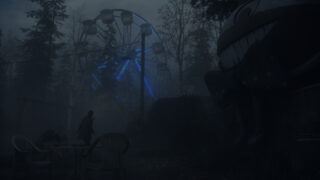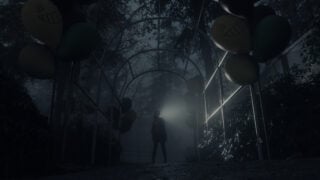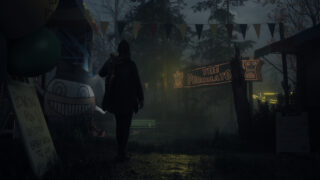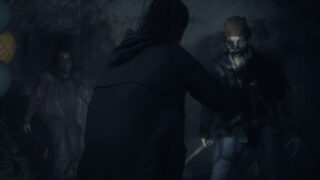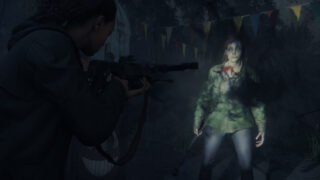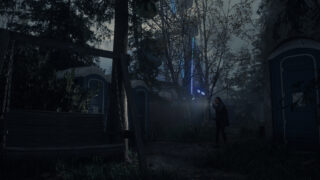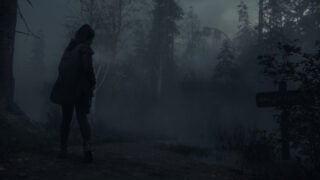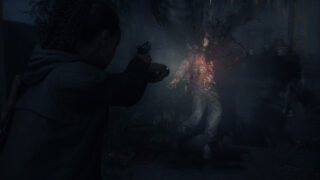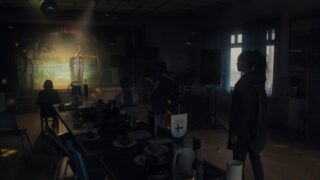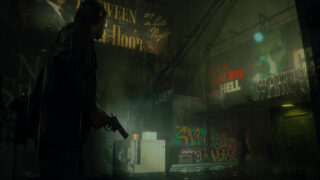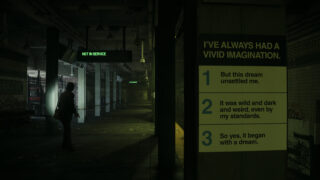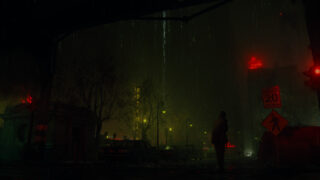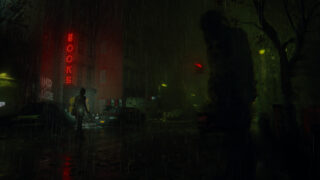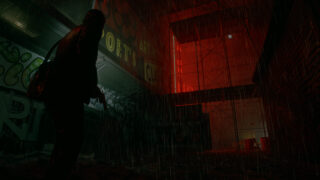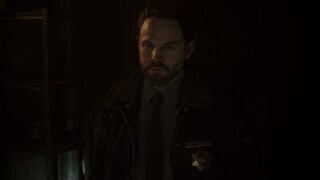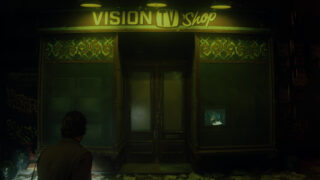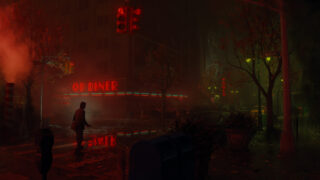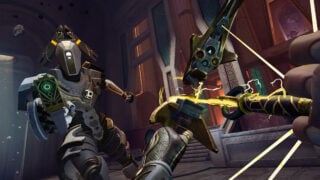Why Remedy is glad it took 13 years to make Alan Wake 2
After more than a decade struggling to get its sequel off the ground, the final result is a bold and ambitious horror game
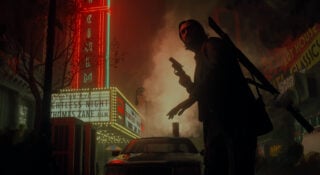
The original version of this article said the game ran on Unreal Engine 5. This has been corrected – the game runs on Remedy’s in-house Northlight Engine.
After more than a decade battling to get a sequel off the ground, Remedy’s creative director Sam Lake took to the stage in Los Angeles earlier this month to present the near-final version of Alan Wake 2 to press. The struggle, he said, had all been worth it.
“It feels fantastic. It’s been such a long journey,” he told members of the press, while visibly holding back emotion. “Looking back, all that pain and suffering along the way was fine, and I guess there are some learnings from a philosophical level on life here.”
Actress Janina Gavankar speaks up: “That’s the quote: ‘all the suffering… it was fine!’”
Given how admirably Remedy has stuck to its roots creating strong, narrative-driven action games, perhaps even more surprising than the 13 years it’s taken for Alan Wake 2, is the fact that the developer hasn’t made a sequel at all for almost exactly 20 years (Max Payne 2 released for PC on October 14, 2003).

That’s certainly not been due to a lack of trying: Since it put its mark on the games industry with stylish cinematic shooter Max Payne in 2001, and then narrative thriller Alan Wake nine years later, the independent Finnish studio spent a decade trying to get Alan Wake 2 greenlit.
With the rise of live service games during the 2010s, original publisher Microsoft wasn’t interested in Remedy’s pitch for an Alan Wake sequel, so the developer tweaked its ideas and came up with Xbox One exclusive Quantum Break (though it managed to sprinkle more than a few Alan Wake Easter Eggs throughout that title, including a live-action mock-trailer).
A second Alan Wake 2 pitch, involving FBI agents searching for the titular writer, evolved into 2018’s critically acclaimed action game Control, after Remedy received feedback that it didn’t feel like an Alan Wake title. That game also had strong links to Alan Wake, minting the ‘Remedy Connected Universe’ with solid narrative ties between the two, including Alan Wake-themed DLC.
With years of practice and multiple drafts under its belt, it’s unsurprising then that Alan Wake 2 – which is the result of part-funding from Epic Games – feels like the culmination of Remedy’s last decade of game development – an ambitious sequel that feels like it could be the boldest interpretation yet of the Remedy-style cinematic action game.
THE SAGA CONTINUES
The original Alan Wake reportedly sold 3.1 million copies – a modest amount for a triple-A action game published by a platform holder. Two console generations later, one of the priorities for the sequel is understandably to cater for those who either didn’t play it, or whose memories have long since faded into the shadows. That means the introduction of a second character, with players able to hop between the two with relative freedom.
How has Remedy stuck to its single-player roots for so long?
Sam Lake: “To be fair, we have multiple projects in the making including some multiplayer. So, from a business perspective, there’s definitely a desire to find our own way of doing these kinds of games as well. But so far, we’ve been lucky and blessed to be allowed to create something like this.
“A big thank you for Alan Wake being able to be so bold in pushing our ideas further than ever before does go to Epic Games Publishing, and [publishing boss] Hector Sanchez in particular when we were pitching this game for funding, because they have been a big part of funding even though Remedy has funded part of it.
“What makes it possible to do something like this is that Hector from the get-go understood what we wanted to make and was excited about it. So I’m happy. Hopefully Alan Wake 2 finds its audience and it’s big enough to make this venture profitable for all parties involved.”
When we start our hands-on session, which begins on the game’s third chapter, we’re in the shoes of FBI agent Saga Anderson, who’s travelled to Bright Falls to investigate a mysterious murder – and eventually, the disappearance of Wake from the original game. Introducing a character that offers a point-of-view to newcomers feels smart, not just from an accessibility standpoint, but tonally it feels fresh.
If the original Alan Wake was inspired by Twin Peaks, then Alan Wake 2’s version of the Pacific Northwest definitely leans towards True Detective. Wearing her FBI-issued windbreaker, Saga nervously creeps through twisted swamp land and abandoned woodland settlements, hoping not to bump into the insane cultists who’re almost certainly responsible for all the murdering in the area.
Powered by Remedy’s Northlight Engine, Alan Wake 2 is a seriously stunning game, with scenes that often overshadow even Capcom’s equally-gorgeous alpine cultist romp Resident Evil 4 remake. In this particular mission, Saga is exploring Watery, a quaint town near the game’s original location of Bright Falls, as she investigates the mysterious Cult of the Tree. The map is like a small hub, with players able to wander freely to nearby points of interest, allowing for Metroidvania-style puzzles as you gain new items and clues.
Saga’s gameplay is much slower-paced than we expected. The first 15 minutes of the mission are spent exploring Watery, encountering its typically weird characters – including the Janitor from Control enjoying a spot of Karaoke. Unsettlingly, some characters Saga speaks to imply that she previously lived in the town, despite her having no knowledge of this. Two characters then tell her about her residence in the nearby trailer park.
Eventually, Saga pulls out her gun and flashlight and wanders into the forest in search of spare keys for the trailer park, which – shock, horror – are locked away in a spooky abandoned theme park called Coffee World. It’s not long before shadowy Taken enemies emerge from the trees, and we’re engaged in combat that feels pleasingly familiar to the first game.
As noted in my own 13-year-old review of the original Alan Wake, the game’s combat felt great, with players combining a flashlight to stun foes before finishing them off with a traditional weapon, and the sequel’s combat feels faithful to that, albeit with a tighter Resident Evil-style over-the-shoulder camera.
However, it did become repetitive in the original, and Remedy hopes a shift further towards survival horror mechanics will benefit the overall experience. In the Saga mission we played, enemies were infrequent but tough – allowing tension to build with each encounter, while ammunition was always in short supply. This makes for some particularly stressful boss encounters, as Saga scrambles to duck out of their path as they manipulate the environment around them with Taken energy.
“I would say the first game was more of an action-oriented game and I think that that was because of the tools that we had available to us at the time and the story that we were looking to make,” principal narrative designer Molly Maloney tells VGC. “It’s been 13 years, and not only has Remedy evolved and changed, but the industry has evolved and changed as well. We have a lot more technical capability than we had at that time.”
To Maloney’s point, the original Alan Wake was very much a game of its era, padding out story sequences with seemingly endless shooting galleries in order to give the player something to do. This time around, Remedy didn’t want to do that.
“In previous Remedy games we’ve always had a strong story component, but it’s not usually been related to gameplay,” Lake tells VGC. “The gameplay has been about action, and the story sort of takes you through that, but there’s not a tone of gameplay that’s about the story.
“I would say the first game was more of an action-oriented game and I think that that was because of the tools that we had available to us at the time and the story that we were looking to make”
“This time around, that was our ambition. Firstly, with the duality of choosing which character you play as, but also how we bring storytelling closer to actual gameplay. That led to, on Saga’s side, she’s an investigator and a profiler, so what does that mean as a gameplay element?”
The solution is a suite of promising core mechanics that attempt to fuse storytelling and gameplay in a way that, should the full game pull it off, will differentiate Alan Wake 2 from other survival horror games and offer something meaningful to players seeking a more engaging narrative experience.
From the off, Saga’s story feels very much like a detective game. Coffee World is littered with clues and puzzles that the game hardly signposts at all: it’s clear the final game is going to be very relaxed in terms of hand-holding the player, which should again please those looking for more challenge than many modern blockbusters, with AI companions blurting out the solution if left alone for 60 seconds, often allow.
Key to this is arguably Alan Wake 2’s most important mechanic, the Mind Place, a sort of interactive pause menu (though Remedy stresses it doesn’t actually pause the game) home to features that will allow players to progress Saga’s investigation. As players collect clues in the game world, they must then piece them together in the imaginary FBI office inside her head.

You can profile key characters you’ve interacted with to learn more about their past, or more importantly, place key clues on a Case Board and identify connections between them. This can help you solve otherwise tricky puzzles, such as by noting that a message on a locked safe in the giftshop could be referencing a code hidden on a nearby staff rota, or even spawn new objectives once Saga’s identified connections.
“In addition to getting Saga’s perspective, the player is the one actively doing it,” explains co-director Kyle Rowley. “They’re pressing buttons, saying things – that was our approach for the conversations, that the player has some agency over how they consume that content, the order in which they do it, so you’re more focused on what you consume and I think we really wanted to find gameplay-driven ways to tell this story in addition to the more traditional linear formats we get like cinematics.”
In a time-limited preview setting, where we were dropped part-way into the full game with no tutorial whatsoever, the Case Board gameplay was admittedly tricky to figure out beyond trial-and-error throwing clues on the wall until they stuck. But with some onboarding, it’s easy to see how it could power a very compelling True Detective-style horror story.
“The challenge [of this preview event] is it’s not the beginning of the game, and we are beyond all the tutorials and the simpler stuff,” Lake tells us. “The Case Board and investigative gameplay in Saga’s Mind Place, and using the Case Board… it’s been a really interesting process finding the balance.
“We had versions of the Case Board where it was crazily complex, with the whole board free to put any clues in there… but it’s still a horror game, so we needed to find that balance where it was streamlined enough for players to be engaged in the story and internalising it by placing the clues, and yet still guiding it enough that you can’t really mess it up.”

WAKE UP
Remedy has acknowledged the existence of two separate campaigns since it first unveiled Alan Wake 2 earlier this year. But our hands-on was the first time anyone has got to try out the titular writer’s spookier and more combat-oriented story, and experience some idea of how the dual-character setup is going to work.
How will Remedy balance sequels and original IP in future?
Sam Lake: “Going back far enough in our history, we did get to make Max Payne 2. I still look back from a writer’s perspective at that being a wonderful project… having the world and many of the characters established, but coming back and expanding on that.
“The whole concept of the Remedy Connected Universe [is that] while they’re standalone experiences and need to be approachable without knowing what came before, it’s still a foundation for exciting and interesting threads to pull from. So from one perspective, you could imagine all of our Remedy connected games, even if it’s an original IP or a sequel, they’re all kind of sequels because they have references to something.
“We are making Vanguard, which is a new IP. So I don’t feel like we will be slowing down necessarily. But I think there are exciting, creative things to be had from sequels. I don’t think ‘sequel’ necessarily means less ambition. I this case, with the 13-year gap, Alan Wake 2 is a completely new experience, even if it is in the same world with some of the same characters.”
Alan Wake 2 allows players to play through the story either as Saga or Alan, with the ability to switch between the two at multiple points during the campaign (think Resident Evil’s safe rooms). The two offer contrasting styles of gameplay and their own points of view of what’s going on in the strange and surreal world, although according to Remedy there will be key points where the two communicate and unify their stories.
“A core theme of the game is duality – two worlds, two characters, fact and fiction,” Maloney explains. “So Saga and Alan have very unique perspectives on the situation, and I actually think agnostic to her being an excellent entry point, she also provides really valuable context as to what’s going on, whereas Alan is very much immersed in what’s going on.”
Most stories with multiple perspectives typically switch between characters at pivotal moments in order to tell the overall story, but Lake says he pushed to avoid this and give more autonomy to the player on which perspective they experience. That means the ability to tackle missions with whatever character you choose, and leaving the writers to worry about ensuring it makes sense.
“I think that fundamentally, from a storytelling perspective, the very early realisation was that if this was a linear story between Saga and Wake, what you would for sure do is take one character to a surprising twist and scary situation, and then cut to another one – your cliffhanger, which is the basic way of telling a story with multiple points of view,” Lake says.
“That was out of the window. We decided we couldn’t do that, because we wanted to encourage the players to find their own pacing. So if they want to continue playing as Saga, they can. If they want to switch to Wake, they can. It meant that cliffhangers on the level of across these two narratives, the rule was, ‘none of that’.
“For sure there are twists, curves and cliffhanger moments inside each of these narratives, like suddenly Alan Wake discovers something he didn’t previously understand and it leads to an exciting situation. But all the cross-referencing in this experience are where there are visions and dreamlike moments, and you start to understand how the characters are seeing the other side.
“It really is intentionally created so that there is no ‘wrong’ pacing or ‘wrong’ way to play through it. That was a big thing to adjust to and then find solutions within that.”
The development team hopes the switching mechanic will allow players to balance their own experience, jumping to Alan’s story when they’re ready for more action-packed gameplay, and switching back to Saga for a breather. And from what we played of Alan’s fifth mission, his side of the story is clearly more intense than that of the investigator.
Alan is trapped in the Dark Place, a nightmarish reality that reacts to his subconscious mind. In this mission, the Dark Place is represented by a Noir-style New York, with neon signs and scrawled graffiti decorating the damp, dirty streets. Alan wrote crime fiction set here, and the Dark Place is a reflection this – a twisted version of the city where it ‘s always moody, nighttime and raining.
Visually, it’s another stunning showcase for the Northlight Engine and a refreshing deviation from pine trees and wood cabins of Bright Falls. Alan’s story is also where players will experience the game’s one-hour of live action cut-scenes, featuring the real-life cast behind its characters, with adds to the surreal ambience of his storyline.
“It really is intentionally created so that there is no ‘wrong’ pacing or ‘wrong’ way to play through it. That was a big thing to adjust to and then find solutions within that.”
Enemies are far more common here, but the experience fighting them is also more tense, as the vast majority of the shadowy figures stumbling through the dimly lit alleyways don’t want to attack you, and you don’t have enough ammo to fight them all, so Alan is instead forced to tiptoe around them, anticipating the inevitable axe swing one of them will launch.
It’s pleasing how much Alan’s experience contrasts with Saga’s. As Maloney mentioned, if Anderson’s story is about fact then Wake’s is about fiction. Saga’s Mind Palace is replaced with the Writer’s Room and the Case Board with the Plot Board. The latter functions in much the same way (from what we can figure out, at least) except Wake’s version rewrites reality as he adds story beats to it.
How significant are the upcoming Max Payne 1&2 remakes?
Sam Lake: “It is a significant undertaking in the sense that even if they are old games, just thinking about bringing them up to modern standards and combining them into one, you can see that it’s a big, big project.”
Will you be reprising your role?
“No comment! That’s going too far.”
Much of the gameplay in the mission we played required manipulating the environment inside of an abandoned hotel, as Alan continues to search for a way out of the Dark Place. A key item in Alan’s arsenal is his Angel Lamp, which players can use to store light from specific areas and transfer it to others, causing the environment to instantly change, revealing the way forward.
Wake is also able to rewrite reality in the Writer’s Room, instantly transforming specific areas of the hotel. For example, switching to the ‘haunted’ reality in the ballroom will instantly fill the scene with a pervasive fog and screeching monstrosities, with new clues to be found to progress the narrative. The near-instant scene transitions are impressive and offer a useful demonstration of what can be done with modern SSD storage.
Remedy’s intention is that the two campaigns mirror each other, with one side predicting the events of the other, or adding valuable context for moments past. It’s most definitely an ambitious concept and you can see why the developer is glad it was able to wait and gestate a bold concept, rather than a comparatively safe follow-up we may have ended up with had it been greenlit earlier.
“I’m so happy that we didn’t get to do it back then,” Lake says, “because I think that we have grown, we have learned and there’s plenty more experience to tap into. The very fact that Alan Wake ended up being trapped in the Dark Place… that’s suffering! And it’s all for the benefit of the story. We couldn’t have done this before now.”



